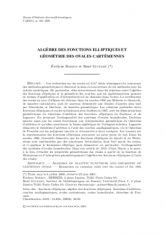Algèbre des fonctions elliptiques et géométrie des ovales cartésiennes
Algebra of Elliptic Functions and Geometry of Cartesian Ovals

- Année : 2001
- Fascicule : 2
- Tome : 7
- Format : Électronique
- Langue de l'ouvrage :
Français - Class. Math. : 01A55, 33E05, 33-03
- Pages : 161-205
- DOI : 10.24033/rhm.113
Les recherches sur les ovales au xixe témoignent du renouveau des méthodes géométriques et illustrent la mise en concurrence de ces méthodes avec les calculs analytiques. En particulier, elles interviennent dans les relations entre l'algèbre des fonctions elliptiques et la géométrie des courbes, que les mathématiciens pensent en termes d'application ou d'interprétation d'un domaine dans l'autre. La rectification des ovales en arcs d'ellipses est obtenue dans les années 1850 par Roberts et Genocchi, de manière calculatoire, puis de nouveau démontrée une dizaine d'années plus tard par Mannheim et Darboux, de manière géométrique. Les relations profondes entre fonctions elliptiques et ovales cartésiennes sont établies en 1867, avec les démonstrations géométriques du théorème d'addition des fonctions elliptiques de Darboux et de Laguerre. En prouvant l'orthogonalité des systèmes d'ovales homofocales, Darboux montre aussi que les ovales fournissent une interprétation géométrique du théorème d'addition et qu'elles constituent la forme algébrique de l'intégrale solution. Laguerre démontre le théorème d'addition à l'aide des courbes anallagmatiques, via le théorème de Poncelet sur les polygones inscrits et circonscrits à deux coniques. Les travaux sur la représentation des fonctions elliptiques procurent un autre point de vue. Dans les années 1880, Greenhill démontre que les fonctions elliptiques de Jacobi et de Weierstrass sont représentées par des quartiques bicirculaires, dont font partie les ovales, et il applique le formulaire elliptique pour démontrer, en particulier, l'orthogonalité des systèmes d'ovales homofocales. Dans son article de 1913, Clara Bacon a le souci, à la fois, d'établir les propriétés géométriques des ovales à partir de la fonction de Weierstrass et d'interpréter géométriquement l'algèbre des fonctions elliptiques à l'aide des ovales.
fonctions elliptiques, algèbre des fonctions elliptiques, théorème d'addition, courbes anallagmatiques, ovales cartésiennes, ovales homofocales, théorème de Poncelet.
